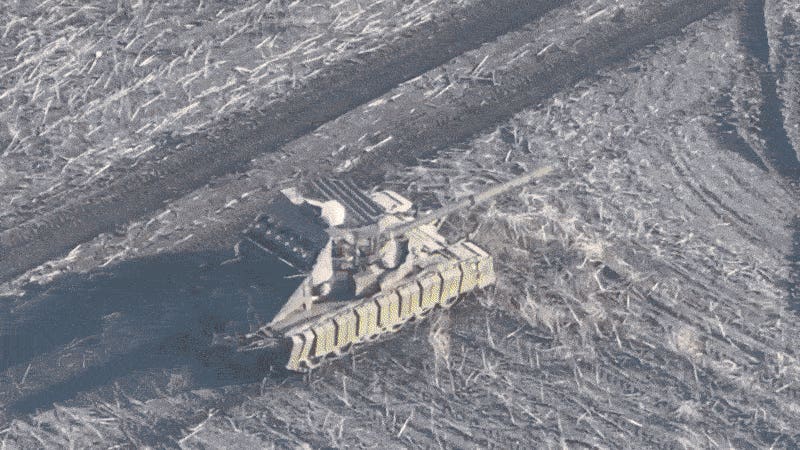A Russian T-80 tank, transformed into a pillar of flames and wreckage by a Ukrainian drone near Pokrovsk on or before Saturday, wasn’t just a tragedy for any Russians in the tank and a spectacle for the Ukrainian drone operators—it was also a symbol of a dangerous dilemma for the Russians as their wider war on Ukraine grinds into its 37th month.
A major Russian offensive is reaching its endgame. And it’s possible only American intervention against Ukraine may reverse the Russians’ faltering fortunes.
For an entire year since capturing the ruins of Avdiivka in eastern Ukraine, the Russian Center Operational Grouping—one of as many as six such groupings along the front line of Russia’s wider war on Ukraine—has been crawling toward the fortress city of Pokrovsk, 30 miles to the west.
The Center Operational Grouping’s forces—on paper, at least 50,000 troops, many of them belonging to the 41st Combined Arms Army—have finally managed to reach Pokrovsk’s outskirts. But it cost them potentially tens of thousands of soldiers and no fewer than 2,200 vehicles including that T-80 that burst into flames this weekend.
According to Gen. Oleksandr Syrskyi, the Ukrainian commander in chief, around 15,000 Russians were “neutralized” around Pokrovsk in January alone.
Ukraine’s own losses in the area have been much lighter since its battered brigades finally retreated from Avdiivka last February. Independent analyst Naalsio has tallied 2,300 destroyed, damaged and captured Russian vehicles on the Pokrovsk axis, but just 700 destroyed, damaged and captured Ukrainian vehicles: a more than three-to-one ratio favoring the Ukrainians.
The staggering losses explain why the Russian may advance near Pokrovsk without actually capturing the city, which anchors a long chain of fortified cities stretching north toward Kharkiv. “The enemy’s Center Operational Grouping on the Pokrovsk direction has made no advances on any of its fronts for three days and was forced to retreat from previously occupied positions in several areas,” the Ukrainian Center for Defense Strategies explained on Saturday.
“The 41st Combined Arms Army is unable to continue its offensive to the north and northwest to accomplish its primary objective—to envelop Pokrovsk from the west and cut off the road to Pavlohrad.”
Stymied, the Russians are pivoting to other objectives. “The Russian command in the theater of war is focusing its main attention not on Pokrovsk but on the adjacent Novopavlivka and Toretsk directions,” CDS explained. And the command is willing to rob the 41st Combined Arms Army in the process, reportedly transferring its most powerful formation—the 90th Tank Division—from the Pokrovsk sector south toward Andriivka, where a pair of Russian regiments have achieved “tactical successes,” according to CDS.
It’s obviously not great news for Russia’s war effort that one of its main offensives is losing momentum. It’s better news for the Russians that their commanders are willing and able to adapt to changing conditions.
Adaptation is the key for both sides as the war grinds on and the politics surrounding it shift. The United States, one of Ukraine’s staunchest allies under former President Joe Biden, is quickly realigning toward Russia under the chaotic leadership of President Donald Trump.
After Ukrainian Pres. Volodymyr Zelensky rejected Trump’s attempt to extort Ukraine for up to $500 billion in mineral wealth, Trump’s administration threatened to cut off Ukraine’s access to Starlink satellite terminals, which many Ukrainian units use to communicate with each other and, equally critically, with their drones.
Starlink is operated by SpaceX, itself largely owned by rightwing billionaire Elon Musk, who was a top Trump donor and is currently heading an extralegal “efficiency” organization that has haphazardly fired tens of thousands of federal employees and gutted entire agencies in Washington, D.C.
Without Starlink, Ukraine may struggle to deploy the very drones that blew up that T-80 and many hundreds of other Russian vehicles on the long bloody road to Pokrovsk. It’s not for no reason that one of Ukraine’s top European allies quickly rose to Ukraine’s defense amid the threats over Starlink access.
“We pay and will continue to pay a subscription fee for satellite internet for Ukraine,” Polish Deputy Prime Minister Krzysztof Gawkowski wrote on X, a Musk-owned social media platform. “I cannot imagine that someone could decide to terminate a business contract for a commercial service to which Poland is a party,” Gawkowski added.
Ukrainian and allied officials would do well to expand their conception of what’s possible in this dangerous new era of American-fueled geopolitical chaos. After all, few imagined that Trump would move so swiftly to not only abandon Ukraine, but also to threaten it—undermining Ukraine’s self-defense at the very moment that defense is complicating Russian war plans.
But he did.
Read the full article here





